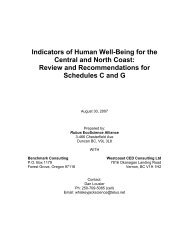Final report - Integrated Land Management Bureau
Final report - Integrated Land Management Bureau
Final report - Integrated Land Management Bureau
You also want an ePaper? Increase the reach of your titles
YUMPU automatically turns print PDFs into web optimized ePapers that Google loves.
KITIMAT<br />
Strengths<br />
• Ice-free, sheltered deepwater passage and<br />
harbour 80nm from great circle shipping route<br />
(international)<br />
• One day closer to Asia than ports in the south.<br />
Its Pacific Inland Coast location enables it to<br />
compete with the southern port of Vancouver<br />
in both rail distance and comparable service<br />
from the Pacific to Chicago and North America<br />
Heartland markets, an advantage not shared<br />
by other Northwest Corridor Ports<br />
• Deep inland location reduces land<br />
transportation costs<br />
• Three deep-sea marine terminals in use for<br />
international imports and a base of operations<br />
for a full-service tugboat operator<br />
• All facilities privately owned and operated.<br />
Operators not required to pay harbour dues,<br />
berthage or wharfage to a Port Authority<br />
• Local labour contracts in facilities; no shipping<br />
disruptions due to national/federal port<br />
transportation labour agreements or conflicts<br />
• Efficient rail connection to Terrace, and US<br />
mid-west destinations<br />
• Private and Provincial Crown land available<br />
• 2,863ha industrial zoned harbour/backup land<br />
available, and total of 11,660ha suitable for<br />
development<br />
Opportunities<br />
• Greatest opportunities lie with export products<br />
– eg., LNG, aggregate<br />
• Asian economies, especially China’s, continue<br />
to record positive growth numbers, and Port of<br />
Prince Rupert is well positioned to access<br />
larger amounts of their container shipments to<br />
North America<br />
• Asian shippers are seeking lowest cost<br />
alternative in current difficult economic<br />
environment<br />
Transportation Assessment of the Central & North Coast of BC<br />
Weaknesses<br />
• Historic dependence on demand for resourcebased<br />
exports (e.g., forest products,<br />
aluminum)<br />
• High pilotage costs associated with need for<br />
two pilots because of duration of trip to/from<br />
Triple Island pilot boarding station<br />
• US infrastructure policy puts BC ports at a<br />
cost disadvantage -- municipal control and<br />
financial flexibility of American west coast<br />
ports lead to lower cost of capital and potential<br />
for lower terminal lease rates<br />
• Has been unable to manufacture aluminum<br />
products because of lower costs of shipping<br />
raw aluminum to assembly centres or markets<br />
for manufacturing there<br />
• No opportunities for container-related work<br />
because there is no container facility in Kitimat<br />
• High infrastructure investment cost required to<br />
get a new port enterprise underway<br />
Threats<br />
• If Alcan modernization does not proceed,<br />
aluminum exports would decline and many<br />
jobs would be lost<br />
• Worldwide economic downturn has slowed<br />
Chinese imports of Canadian commodities in<br />
the short term<br />
• Competition from American west coast ports,<br />
which have more organizational and legal<br />
flexibility to respond to economic downturn<br />
conditions<br />
Chisholm Consulting 73

















